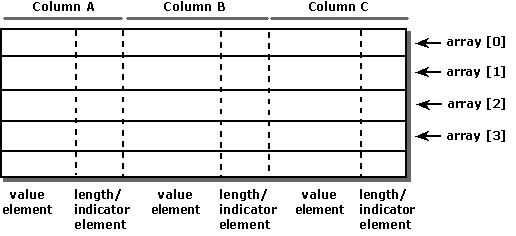按行绑定
使用按行绑定时,应用程序为将返回数据的每一列定义一个结构,该结构将包含一个、两个或(在某些情况下)三个元素。 第一个元素保存数据值,第二个元素保存长度/标记缓冲区。 标记和长度值可以通过将 SQL_DESC_INDICATOR_PTR 和 SQL_DESC_OCTET_LENGTH_PTR 描述符字段设置为不同的值来存储在单独的缓冲区中;如果执行了此操作,则该结构将包含第三个元素。 然后,应用程序会分配这些结构的数组,其中元素数与行集中的行数相同。
应用程序使用 SQL_ATTR_ROW_BIND_TYPE 语句属性向驱动程序声明结构的大小,并绑定数组第一个元素中每个成员的地址。 因此,驱动程序可以计算特定行和列的数据地址,
Address = Bound Address + ((Row Number - 1) * Structure Size)
其中,行编号为从 1 到行集的大小值。 (从行号减去一,因为 C 中的数组索引是从零开始的。下图显示了按行绑定的工作原理。 通常,只有将被绑定的列才会包含在结构中。 该结构可能包含与结果集列无关的字段。 这些列可能以按任意顺序放置在结构中,但为了清楚起见,这些列将按顺序显示。

例如,下面的代码创建一个结构,其中包含用于返回 OrderID、SalesPerson 和 Status 列的数据以及 SalesPerson 和 Status 列的长度/标记的元素。 该代码将分配 10 个这样的结构,并将其绑定到 OrderID、SalesPerson 和 Status 列。
#define ROW_ARRAY_SIZE 10
// Define the ORDERINFO struct and allocate an array of 10 structs.
typedef struct {
SQLUINTEGER OrderID;
SQLINTEGER OrderIDInd;
SQLCHAR SalesPerson[11];
SQLINTEGER SalesPersonLenOrInd;
SQLCHAR Status[7];
SQLINTEGER StatusLenOrInd;
} ORDERINFO;
ORDERINFO OrderInfoArray[ROW_ARRAY_SIZE];
SQLULEN NumRowsFetched;
SQLUSMALLINT RowStatusArray[ROW_ARRAY_SIZE], i;
SQLRETURN rc;
SQLHSTMT hstmt;
// Specify the size of the structure with the SQL_ATTR_ROW_BIND_TYPE
// statement attribute. This also declares that row-wise binding will
// be used. Declare the rowset size with the SQL_ATTR_ROW_ARRAY_SIZE
// statement attribute. Set the SQL_ATTR_ROW_STATUS_PTR statement
// attribute to point to the row status array. Set the
// SQL_ATTR_ROWS_FETCHED_PTR statement attribute to point to
// NumRowsFetched.
SQLSetStmtAttr(hstmt, SQL_ATTR_ROW_BIND_TYPE, sizeof(ORDERINFO), 0);
SQLSetStmtAttr(hstmt, SQL_ATTR_ROW_ARRAY_SIZE, ROW_ARRAY_SIZE, 0);
SQLSetStmtAttr(hstmt, SQL_ATTR_ROW_STATUS_PTR, RowStatusArray, 0);
SQLSetStmtAttr(hstmt, SQL_ATTR_ROWS_FETCHED_PTR, &NumRowsFetched, 0);
// Bind elements of the first structure in the array to the OrderID,
// SalesPerson, and Status columns.
SQLBindCol(hstmt, 1, SQL_C_ULONG, &OrderInfoArray[0].OrderID, 0, &OrderInfoArray[0].OrderIDInd);
SQLBindCol(hstmt, 2, SQL_C_CHAR, OrderInfoArray[0].SalesPerson,
sizeof(OrderInfoArray[0].SalesPerson),
&OrderInfoArray[0].SalesPersonLenOrInd);
SQLBindCol(hstmt, 3, SQL_C_CHAR, OrderInfoArray[0].Status,
sizeof(OrderInfoArray[0].Status), &OrderInfoArray[0].StatusLenOrInd);
// Execute a statement to retrieve rows from the Orders table.
SQLExecDirect(hstmt, "SELECT OrderID, SalesPerson, Status FROM Orders", SQL_NTS);
// Fetch up to the rowset size number of rows at a time. Print the actual
// number of rows fetched; this number is returned in NumRowsFetched.
// Check the row status array to print only those rows successfully
// fetched. Code to check if rc equals SQL_SUCCESS_WITH_INFO or
// SQL_ERRORnot shown.
while ((rc = SQLFetchScroll(hstmt,SQL_FETCH_NEXT,0)) != SQL_NO_DATA) {
for (i = 0; i < NumRowsFetched; i++) {
if (RowStatusArray[i] == SQL_ROW_SUCCESS|| RowStatusArray[i] ==
SQL_ROW_SUCCESS_WITH_INFO) {
if (OrderInfoArray[i].OrderIDInd == SQL_NULL_DATA)
printf(" NULL ");
else
printf("%d\t", OrderInfoArray[i].OrderID);
if (OrderInfoArray[i].SalesPersonLenOrInd == SQL_NULL_DATA)
printf(" NULL ");
else
printf("%s\t", OrderInfoArray[i].SalesPerson);
if (OrderInfoArray[i].StatusLenOrInd == SQL_NULL_DATA)
printf(" NULL\n");
else
printf("%s\n", OrderInfoArray[i].Status);
}
}
}
// Close the cursor.
SQLCloseCursor(hstmt);
反馈
即将发布:在整个 2024 年,我们将逐步淘汰作为内容反馈机制的“GitHub 问题”,并将其取代为新的反馈系统。 有关详细信息,请参阅:https://aka.ms/ContentUserFeedback。
提交和查看相关反馈